The constellations in tonight’s sky host many familiar star patterns. For northern observers, autumn is the best time of the year to see the Northern Cross in Cygnus (the Swan), Cassiopeia’s W, and the Great Square of Pegasus. These bright, recognizable asterisms dominate the evening sky.
For observers in the southern hemisphere, the zodiac constellations Aquarius (the Water Bearer) and Capricornus (the Sea Goat) are high overhead in the evening, as are the four constellations known as the Southern Birds: Phoenix, Grus (the Crane), Tucana (the Toucan), and Pavo (the Peacock). Most of these constellations do not stand out in the sky, but they can be identified using their brighter stars and star patterns.
The night sky tonight looks different depending on the location. The constellation maps below show the sky at around 10 pm in the mid-northern, equatorial, and mid-southern latitudes.
Northern hemisphere
For northern observers, the constellations Pegasus (the Winged Horse), Cassiopeia (the Queen) and Cygnus (the Swan) are high overhead in the evening. Pegasus is easily recognizable because its bright stars Algenib, Scheat and Markab form the Great Square of Pegasus with Alpheratz in the neighbouring Andromeda (the Princess).
The Square of Pegasus is a large autumn asterism that outlines the main body of the celestial horse. It can be used to find the less conspicuous constellations Aquarius and Pisces, as well as the faint Lacerta (the Lizard) and Equuleus (the Foal).
The five brightest stars of Cassiopeia form a distinctive W (or M) in the sky. The W pattern can be used to find the fainter Cepheus (the King), recognizable for the stick house asterism that sits above the W.
Cygnus is another prominent constellation in the autumn sky. The body of the celestial Swan is outlined by a bright, large asterism known as the Northern Cross. The asterism is formed by Deneb, Sadr, Albireo, Fawaris, and Aljanah. All five stars have already evolved away from the main sequence and entered the final stages of their life cycles.
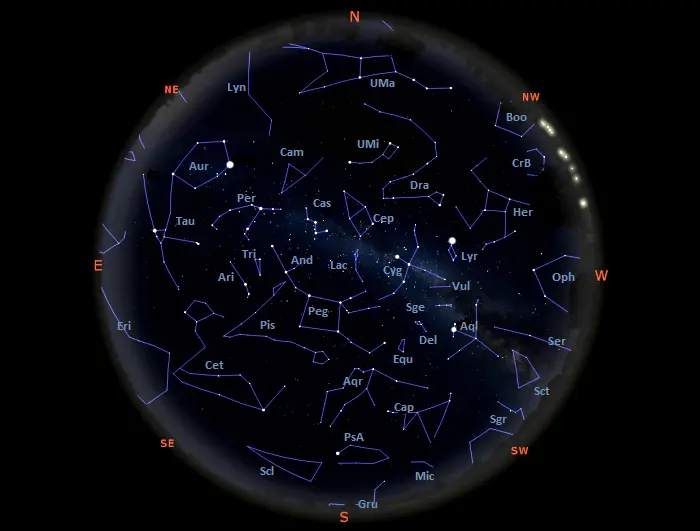
Tonight’s sky as seen from mid-northern latitudes, image: Stellarium
The supergiant Deneb sits at the top of the Northern Cross and marks the celestial Swan’s tail. It is part of the brighter and larger Summer Triangle asterism, which it forms with the brighter Vega in the constellation Lyra (the Lyre) and Altair in Aquila (the Eagle).
Sadr, another supergiant, lies at the centre of the Cross. The star is surrounded by a large diffuse nebula known as the Sadr Region or Gamma Cygni Nebula (IC 1318). Albireo, the faintest of the five stars, marks the bottom of the Northern Cross. It is an orange bright giant that forms a striking contrasting visual double star with its hot blue neighbour Albireo B.
Aljanah and Fawaris, the stars that mark the Swan’s wings, outline the beam of the Northern Cross with Sadr. Aljanah is an orange giant located 72.7 light-years away and Fawaris is a more luminous A-type subgiant 165 light-years away. Aljanah can be used to find the Veil Nebula, a large supernova remnant 3 degrees across.
Eastern sky
The eastern sky is dominated by Taurus (the Bull) and Perseus. Both constellations are very easy to recognize. Taurus is home to the Pleiades and the Hyades, the brightest and largest open clusters in the sky. The V-shaped Hyades cluster outlines the head of the Bull, while the Pleiades mark the Bull’s shoulder.
Perseus rises earlier in the evening, just after Cassiopeia. Mirfak (Alpha Persei), the constellation’s brightest star, is found along the imaginary line extended from Gamma Cassiopeiae, the central star of Cassiopeia’s W, through Ruchbah (Delta Cassiopeiae), the bottom left star of the W.
Mirfak is part of the Segment of Perseus, a curving pattern of stars that stretches between Cassiopeia and Auriga (the Charioteer). It is also the brightest star in the Alpha Persei Cluster (Collinder 39), a young open cluster easily observed in binoculars. With an apparent magnitude of 1.2 and an apparent size of 185 arcminutes, the cluster is visible to the unaided eye on a clear night.
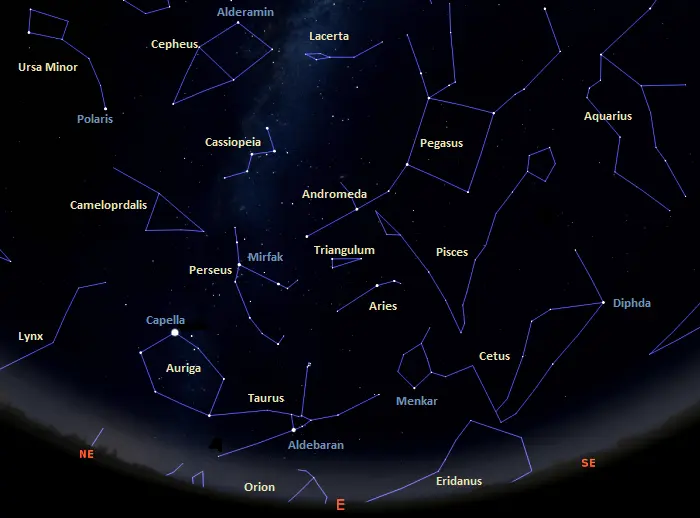
Eastern sky in the northern hemisphere, image: Stellarium
Auriga, the Charioteer, rises before 10 pm in the northeastern sky. The constellation is dominated by a large hexagon that includes Capella, the sixth brightest star in the sky, and Elnath in the neighbouring constellation Taurus.
Andromeda, Triangulum (the Triangle) and Aries (the Ram) appear higher in the eastern sky. Andromeda, the home of the Andromeda Galaxy (M31), can be identified using the Great Square of Pegasus and the Segment of Perseus. Alpheratz, Andromeda’s brightest star, is part of the Great Square asterism. It forms a chain with the Andromeda stars Mirach and Almach that stretches between Pegasus and Perseus.
Triangulum and Aries both have triangular constellation figures. Triangulum looks like an elongated triangle below Mirach and Almach, and the brightest stars in Aries – Hamal, Sheratan and Mesarthim – form a flat triangle that lies between Triangulum and the head of Cetus (the Sea Monster).
Cetus and Pisces, the fourth and 14th largest constellations in the sky, appear in the southeastern sky. The head of Cetus is found using the V-shaped head of the Bull as a pointer. The heads of the two fishes represented by Pisces can be found using the Square of Pegasus and the bright stars of Andromeda.
The Circlet of Pisces is the most recognizable feature of the constellation Pisces. It represents the head of the western fish and appears southeast of the Square of Pegasus. The head of the fainter eastern fish is found near Mirach, the central star in the chain of three bright stars in Andromeda.
Mirach is commonly used to find two exceptionally bright galaxies: the Andromeda Galaxy (M31) and the Triangulum Galaxy (M33). As their names suggest, the galaxies lie in the constellations Andromeda and Triangulum. The two members of the Local Group of galaxies are the most distant objects visible to the unaided eye.
Northern sky
The northern evening sky is populated by several circumpolar constellations: Ursa Minor (the Little Bear), Ursa Major (the Great Bear), Draco (the Dragon), Camelopardalis (the Giraffe), Cepheus (the King), and Cassiopeia (the Queen).
Polaris, the North Star, appears directly above the northern horizon. It marks the end of the Little Dipper’s handle and the tip of the Smaller Bear’s tail. At this time of the year, the Dipper’s handle appears parallel to the horizon in the evening.
Kochab and Pherkad, the bright outer stars of the Little Dipper’s bowl, are known as the Guardians of the Pole because they always circle close to Polaris. The middle four stars that form the Little Dipper are much fainter and challenging to see in less-than-ideal conditions.
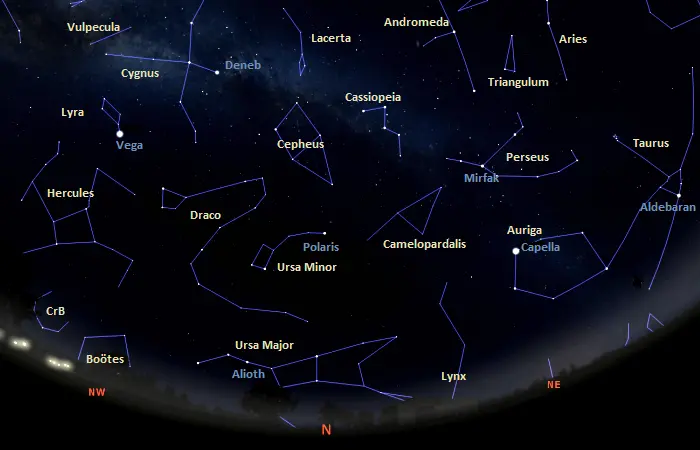
Northern sky in the northern hemisphere, image: Stellarium
The Great Bear sits low above the northern horizon. Its seven bright stars form the Big Dipper, one of the most recognizable asterisms in the northern sky. Merak and Dubhe, the outer stars of the Big Dipper’s bowl, are known as the Pointer Stars. They point toward Polaris and the north celestial pole.
Draco, the eighth largest constellation in the sky, can be found using the Big and Little Dippers. The Dragon’s tail lies between the two asterisms and the rest of its body winds around the Little Dipper’s bowl in the direction of Cygnus and Hercules. The head of Draco can be found by extending a line through the beam of the Northern Cross in Cygnus.
The faint Camelopardalis (the Giraffe) can be made out between Polaris and Mirfak on a clear, dark night. Lynx, another challenging target from light-polluted areas, is found between the head of the Great Bear and the hexagon of Auriga (the Charioteer).
Western sky
The constellations setting in the west in the evening include Ophiuchus (the Serpent Bearer), Serpens (the Snake), Aquila (the Eagle), and Hercules. The constellations of the Summer Triangle – Cygnus, Lyra, and Aquila – appear high in the western sky.
Lyra is dominated by a parallelogram asterism that represents the celestial Harp and appears next to Vega, the fifth brightest star in the sky. The small but distinctive constellation can be used to find the fainter Hercules.
The Keystone, an asterism formed by four relatively bright stars in Hercules, is the most identifiable part of the constellation. It appears between Vega and the semi-circle formed by the brightest stars of Corona Borealis, the Northern Crown. The asterism outlines the torso of Hercules and can be used to find the bright globular clusters Messier 13 and Messier 92.
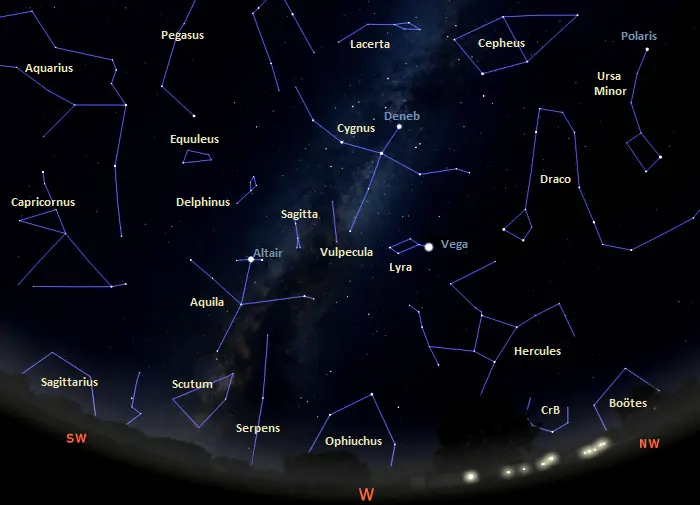
Western sky in the northern hemisphere, image: Stellarium
Ophiuchus and Serpens have mostly set by 10 pm. Rasalhague, the brightest star in Ophiuchus and the top star in the constellation’s polygonal figure, can be spotted above the western horizon in the evening.
Aquila (the Eagle) flies opposite Cygnus (the Swan) in the sky. Altair, the constellation’s brightest star, forms the Summer Triangle with Vega in Lyra and Deneb in Cygnus. The star is easy to identify because it is flanked by two other relatively bright stars, Tarazed and Alshain.
Sagitta (the Arrow) appears between Altair at the Eagle’s head (or neck) and Albireo at the Swan’s beak. The constellation is small but distinctive and can be easily made out on a clear night. The fainter Vulpecula (the Fox), the home of the Dumbbell Nebula (Messier 27) is a more difficult target. It appears in the region between Albireo and the constellation figure of Sagitta.
Southern sky
The constellations appearing above the southern horizon at this time of the year are relatively inconspicuous but can be found using the bright stars of the Great Square of Pegasus. Pegasus appears high in the sky and can be used to find the faint zodiac constellations Pisces and Aquarius.
Pisces appears in the southeastern sky. The constellation’s most recognizable asterism, the Circlet of Pisces, appears directly below the Square of Pegasus.
The brightest stars in Aquarius, the supergiants Sadalsuud and Sadalmelik, form an asterism known as the Lightning Bolt with Enif, the brightest star in Pegasus, and Deneb Algedi, the luminary of Capricornus.
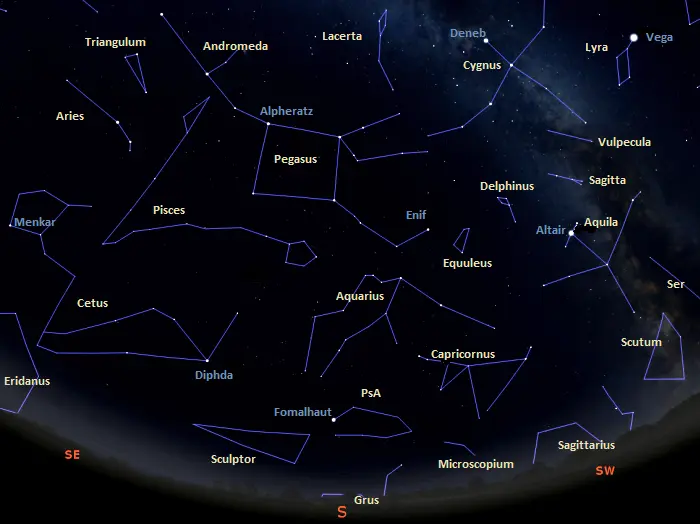
Southern sky from the northern hemisphere, image: Stellarium
Aquarius can be identified using the Water Jar, a Y-shaped asterism appearing below the imaginary line connecting the southwestern corner of the Square of Pegasus and Enif. The faint stars that represent the water flowing from the Water Jar toward the mouth of the Southern Fish are visible on a clear night.
The faint V of Capricornus can be found using the Shaft of Aquila, an asterism formed by Altair with its neighbours Alshain and Tarazed. The three stars form a line that points toward the right side of the V figure.
Piscis Austrinus (the Southern Fish) can be found using the bright stars of the Great Square of Pegasus. An imaginary line extended through the rightmost stars of the Square across the sky leads to Fomalhaut, the star marking the mouth of the Southern Fish. Fomalhaut is the 18th brightest star in the sky. It is the only first-magnitude star in this region of the sky and appears relatively isolated because the rest of Piscis Austrinus is much fainter.
The faint Sculptor appears above the southern horizon in the evening. The blue giant Alpha Sculptoris, the constellation’s brightest star, shines at magnitude 4.30 and is a difficult target from urban areas. The constellation is home to the Sculptor Galaxy (NGC 253), one of the brightest galaxies in the sky and a popular target for backyard telescopes. The starburst galaxy has an apparent magnitude of 8.0 and an apparent size of 27.5 by 6.8 arcminutes. It appears near Diphda, the brightest star in Cetus (the Sea Monster).
Equatorial latitudes
Observers in equatorial latitudes see many of the same constellations as those in mid-northern locations, but these constellations do not appear in the same place. Additionally, observers near the equator can see many constellations in the southern sky that are invisible to northern observers.
From locations near the equator, Pegasus (the Winged Horse), Pisces (the Fish), Cetus (the Sea Monster), and Aquarius (the Water Bearer) appear high overhead in the evening. The Great Square of Pegasus, the most prominent feature of Pegasus, dominates the evening sky. The other three constellations are less conspicuous and can be found using the four stars of the Great Square.
Pisces, the 14th largest constellation in the sky, occupies the area east and south of the Great Square. The Circlet of Pisces, the asterism that outlines the head of the western fish, appears south of the Pegasus asterism.
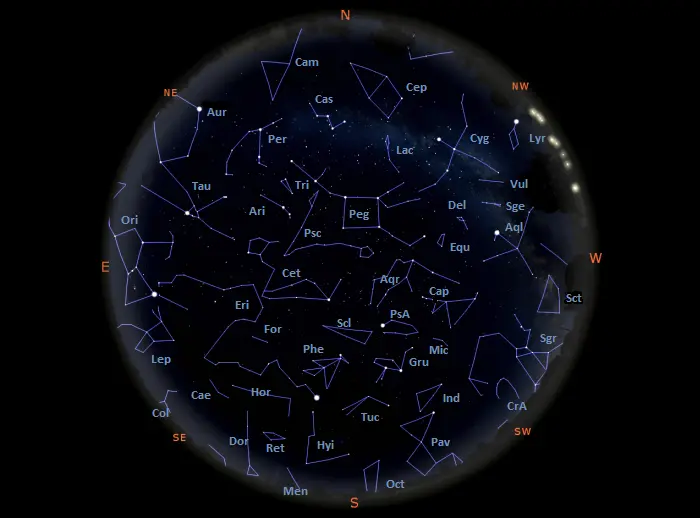
Tonight’s sky as seen from equatorial latitudes, image: Stellarium
The Water Jar of Aquarius appears below the imaginary line connecting the southwest corner of the Great Square and Enif, the brightest star in Pegasus.
Diphda, the luminary of Cetus, appears on the imaginary line extended from the eastern side of the Great Square. The star marks the tail of the Sea Monster.
Menkar, the constellation’s second brightest star, appears in the head of Cetus. Menkar can be found using the stars of the Hyades cluster, which form the head of the Bull. The V-shaped cluster points in the direction of the Sea Monster’s head.
Northern sky
Cepheus and Cassiopeia (the King and the Queen) are the most prominent constellations above the northern horizon in the evening. Cassiopeia’s five brightest stars form a distinctive W in the sky. The W appears as an M from equatorial locations and the house pattern of Cepheus is visible northwest of it.
The constellations of the Summer Triangle – Cygnus (the Swan), Aquila (the Eagle) and Lyra (the Lyre) – appear in the northwestern sky, and the bright Perseus and Auriga (the Charioteer) dominate the northeastern sky.
The faint Lacerta (the Lizard) is visible between Cassiopeia and Cygnus. Camelopardalis (the Giraffe), another faint northern constellation, appears in the region between Cepheus and Capella, the brightest star in Auriga, on a clear night.
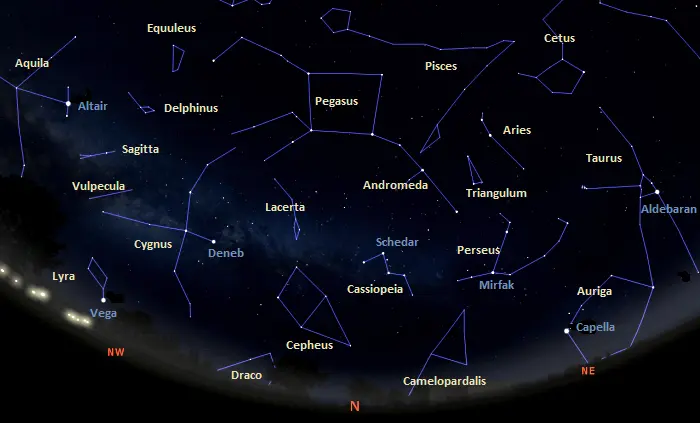
Northern sky from equatorial latitudes, image: Stellarium
Eastern sky
The constellations rising in the east around 10 pm are Orion (the Hunter), Taurus (the Bull), and Lepus (the Hare). The crooked hourglass pattern of Orion appears parallel to the horizon with the Hunter’s shield pointing up. The figure of Orion is outlined by Rigel, Betelgeuse, Bellatrix and Saiph. Meissa marks the Hunter’s head, and Orion’s Belt is formed by Alnitak, Alnilam and Mintaka.
With the exception of Betelgeuse, all these are hot, luminous, blue O- and B-type stars. Betelgeuse is a cool red supergiant with a radius about 764 times that of the Sun and a mass of 16.5 – 19 Suns. It sits at Orion’s shoulder. Bellatrix marks the other shoulder, and the blue supergiants Rigel and Saiph mark the Hunter’s feet. Both Rigel and Betelgeuse are first-magnitude stars. Rigel is the seventh brightest star in the sky and Betelgeuse the tenth.
Taurus is home to two exceptionally bright open clusters, the Pleiades and the Hyades. Both appear along the imaginary line extended from Orion’s Belt. The Pleiades cluster marks the celestial Bull’s shoulder and the brightest Hyades stars outline the Bull’s head.
Aldebaran, the constellation’s brightest star, appears in the same line of sight as the Hyades and marks one of the Bull’s eyes. The orange giant Ain (Epsilon Tauri), one of the brightest Hyades stars, marks the other.
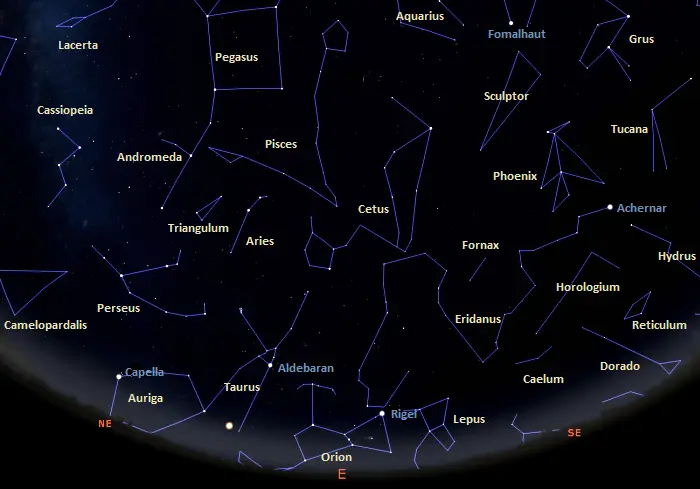
Eastern sky from equatorial latitudes, image: Stellarium
The small constellation Lepus (the Hare) appears at Orion’s feet. In mythology, Lepus represents a hare chased by Orion and his two dogs, Canis Major (the Great Dog) and Canis Minor (the Little Dog). The yellow-white supergiant Arneb, the brightest star in Lepus, shines at magnitude 2.59 from a distance of 2,200 light-years.
Eridanus, the sixth largest of the 88 constellations, represents the celestial River. It stretches from Rigel in Orion all the way to the far southern sky, where Achernar, the ninth brightest star in the sky, marks its end. The white giant Cursa, the second brightest star in Eridanus, appears at the constellation’s northeastern end, near Rigel in Orion.
Cetus (the Sea Monster), the fourth largest constellation in the sky, appears high above the horizon in the evening. It occupies much of the space between Pisces and Eridanus. Its brightest stars, the orange giant Diphda (Beta Ceti) and red giant Menkar (Alpha Ceti), lie at opposite ends of the constellation. Menkar appears in the head of Cetus and Diphda in the tail.
Western sky
Aquila (the Eagle) is the most prominent constellation setting in the west in the evening. Altair, its brightest star, is part of the Summer Triangle, along with Deneb in Cygnus (the Swan) and Vega in Lyra (the Lyre). The asterism appears in the northwestern sky around 10 pm. Altair forms a smaller asterism known as the Shaft of Aquila (or the Family of Aquila) with the two fainter stars flanking it, Alshain and Tarazed. The asterism makes the stars very easy to identify.
Altair can be used to find two small but recognizable constellations that appear in the area between the star and the wing of Cygnus (the Swan). These are Delphinus (the Dolphin) and Sagitta (the Arrow). The constellations are easy to spot because their dominant star patterns resemble the shapes of a dolphin and an arrow.
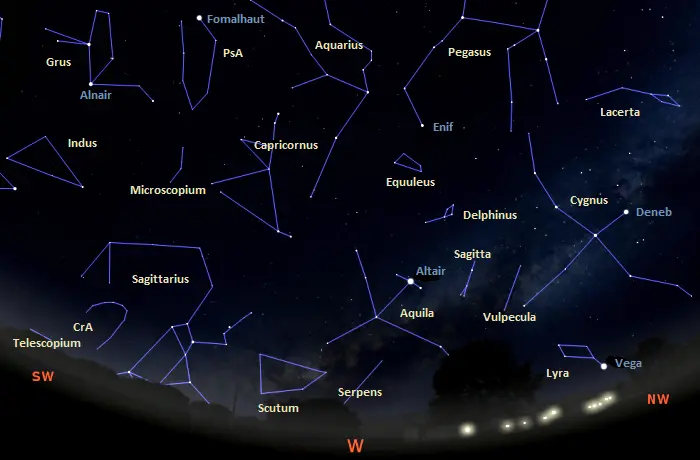
Western sky from equatorial latitudes, image: Stellarium
The bright Sagittarius (the Archer) sets in the southwest in the evening. The Teapot asterism, formed by the brightest Sagittarius stars, has partly set by 10 pm. Capricornus (the Sea Goat) appears higher in the western sky but its V-shaped constellation figure is difficult to make out from light-polluted areas.
The fainter Scutum (the Shield) lies between Sagittarius and the tail of Aquila (the Eagle). The constellation contains the Wild Duck Cluster (M11), one of the brightest and most massive open clusters known.
Southern sky
Achernar, the ninth brightest star in the sky, is the brightest point of light above the southern horizon. The hot blue star marks the end of the celestial River (Eridanus). The rest of the constellation Eridanus winds across the sky in the direction of Rigel in the east.
The Southern Birds – Phoenix, Grus (the Crane), Tucana (the Toucan), and Pavo (the Peacock) – appear north and west of Achernar. The brightest star northwest of Achernar is the orange giant Ankaa, the luminary of Phoenix. The star’s name is derived from the Arabic word for “phoenix.” Ankaa shines at magnitude 2.377 from a distance of 82 light-years. Like Peacock and Alnair, the brightest stars in Pavo and Grus, Ankaa is one of the 58 stars selected for use in celestial navigation.
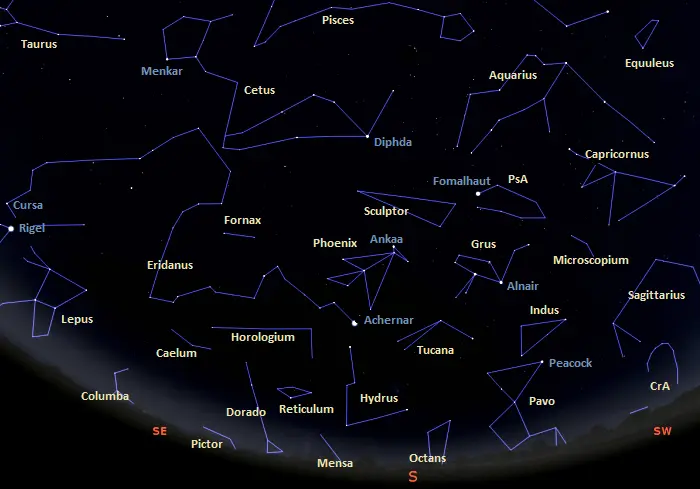
Southern sky from equatorial latitudes, image: Stellarium
The faint Reticulum (the Reticle) and Horologium (the Pendulum Clock) appear south of Eridanus. Their brightest stars, the yellow giant Alpha Reticuli and orange giant Alpha Horologii, shine at magnitudes 3.315 and 3.853 respectively.
Hydrus (the Lesser Water Snake) appears directly above the southern horizon. The yellow subgiant Beta Hydri, the constellation’s brightest star, is the nearest reasonably bright star to the south celestial pole. It has an apparent magnitude of 2.80 and lies 24.33 light-years away.
Hydrus and the neighbouring Tucana host the Small Magellanic Cloud (SMC), a dwarf galaxy that appears as a detached piece of the Milky Way on a clear night. It is one of our galaxy’s closest neighbours. Its bigger brother, the Large Magellanic Cloud (LMC), lies in the constellations Dorado (the Dolphinfish) and Mensa (Table Mountain), which appear closer to the horizon around 10 pm.
Southern hemisphere
The constellations that appear high overhead in the evening for observers in the southern hemisphere are Capricornus (the Sea Goat), Aquarius (the Water Bearer), Piscis Austrinus (the Southern Fish), Sculptor, Grus (the Crane), Indus (the Indian), and Microscopium (the Microscope).
Piscis Austrinus is the only one of these constellations that contains a first-magnitude star. Fomalhaut, the constellation’s luminary, is an A-type main sequence star that shines at magnitude 1.16 from a distance of 25.13 light-years. It is one of the hottest stars in the solar neighbourhood. It has a circumstellar disk of dust that has earned it the nickname the Eye of Sauron. Fomalhaut is the brightest star along the imaginary line extended from the western side of the Great Square of Pegasus. It is the 18th brightest star in the sky.
Sculptor lies east of Piscis Austrinus but is a difficult target in light-polluted skies. The constellation’s brightest star, Alpha Sculptoris, has an apparent magnitude of 4.30. It can be used to find the Sculptor Galaxy (NGC 253) and the Claw Galaxy (NGC 247). The galaxies lie in the region between Alpha Sculptoris and Diphda, the brightest star in Cetus (the Sea Monster).
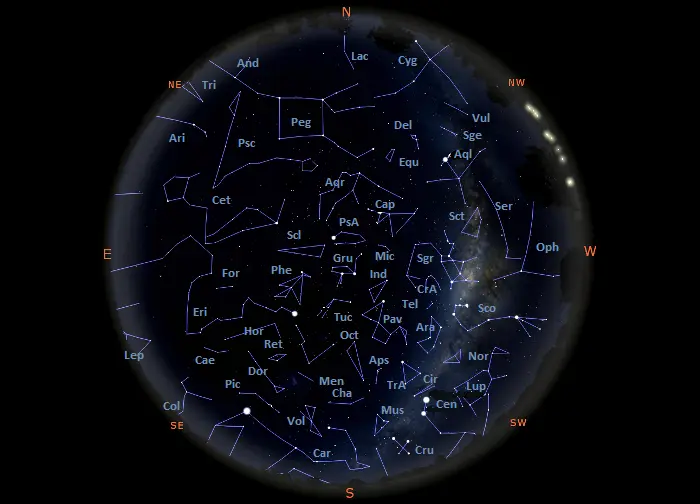
Tonight’s sky as seen from the southern hemisphere, image: Stellarium
The constellation Capricornus is difficult to make out from urban areas. Its main star pattern is a large faint V that appears roughly halfway between the Square of Pegasus and the Fish Hook of Scorpius.
The neighbouring zodiac constellation Aquarius is just as inconspicuous. Its identifying feature, the Water Jar asterism, is found below the imaginary line connecting Enif, the brightest star in Pegasus, and the southwestern corner of the Great Square of Pegasus.
The constellations Grus (the Crane) and Indus (the Indian) appear high above the horizon at this time of the year. Grus was once considered to be part of Piscis Austrinus and can be found south of Fomalhaut.
The fainter Indus appears west of Grus, near the feet of Sagittarius (the Archer). Its brightest star, Alpha Indi (the Persian), is an orange giant with an apparent magnitude of 3.11. The constellation also hosts Epsilon Indi, one of the nearest visible stars to Earth. The star lies only 11.867 light-years away.
Microscopium, one of the smallest and faintest constellations in the sky, appears between Indus and Capricornus. The constellation’s brightest star, the variable yellow giant Gamma Microscopii, shines at magnitude 4.68 and is a challenging target from light-polluted areas.
Northern sky
The Great Square of Pegasus dominates the northern sky in the evening. Formed by the Pegasus stars Algenib, Markab, and Scheat with Alpheratz in Andromeda, the asterism is commonly used to find the smaller and fainter constellations in the vicinity. The supergiant Enif, the brightest star in Pegasus, can be used to locate the Great Pegasus Cluster (Messier 15), which lies in the direction of Delphinus (the Dolphin).
The most prominent star pattern in Delphinus is Job’s Coffin, an asterism formed by four stars that outline the Dolphin’s body.
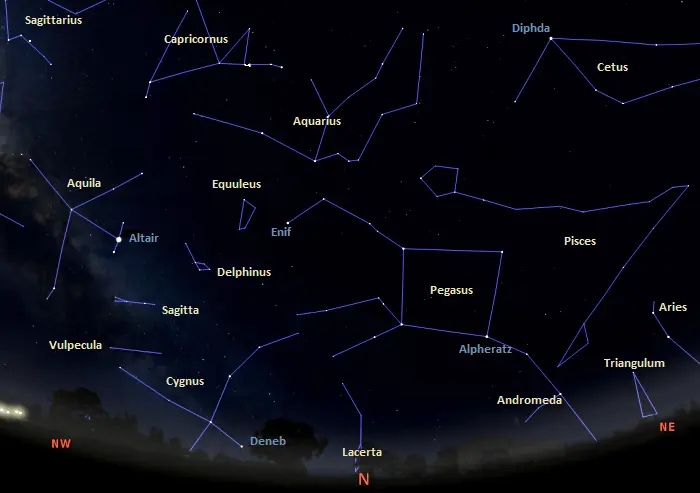
Northern sky in the southern hemisphere, image: Stellarium
The four stars of the Great Square of Pegasus make it easy to find the Circlet of Pisces, an asterism outlining the head of the western fish in Pisces. The asterism appears high above the northern horizon around 10 pm.
Cygnus (the Swan) sets in the northwest, and Andromeda (the Princess) is visible above the northeastern horizon. The Andromeda Galaxy (Messier 31) can be spotted low above the horizon in binoculars and small telescopes.
Eastern sky
Cetus (the Sea Monster) and Eridanus (the River) are the largest constellations rising in the east.
Cetus is the fourth largest of the 88 modern constellations. Its brightest star, Diphda, is found along the imaginary line extended from Alpheratz through Algenib in the Great Square of Pegasus. Traditionally known as Deneb Kaitos (meaning “the tail of the Sea Monster”), the orange giant star is part of Cetus’ tail. The head of Cetus is outlined by the red giant Menkar, the constellation’s second brightest star, and several fainter stars.
The famous pulsating variable red giant Mira (Omicron Ceti) lies in the neck of the Sea Monster. The bright barred spiral galaxy Messier 77, sometimes called the Squid Galaxy, appears roughly halfway between Mira and Menkar.
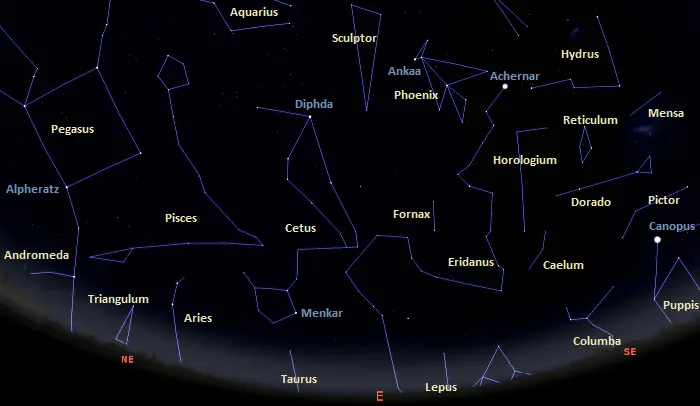
Eastern sky in the southern hemisphere, image: Stellarium
Eridanus, the sixth largest constellation in the sky, takes up a good portion of the eastern and southeastern sky. Achernar, the brightest star in the constellation, is high above the horizon by 10 pm, while Cursa at the other end of the celestial River rises later in the evening.
Pisces, the 14th largest constellation in the sky, appears in the northeast. The head of the western fish is high in the sky, while the eastern fish is close to the horizon around 10 pm. The smaller Aries (the Ram) and Triangulum (the Triangle) appear above the northeastern horizon.
Fornax (the Furnace) is one of the fainter southern constellations. Its brightest star, Dalim, shines at magnitude 3.80. The constellation appears in the bend of Eridanus but is a challenging target from light-polluted locations.
Western sky
Scorpius (the Scorpion) and Sagittarius (the Archer) dominate the western evening sky. The two zodiac constellations are very easy to identify. Scorpius is home to Antares, the 15th brightest star in the sky. The red supergiant marks the Scorpion’s heart and is part of an asterism known as the Fish Hook, which curves from Antares to Shaula at the Scorpion’s stinger. Antares connects the Fish Hook and the Scorpion’s claws.
Sagittarius is known for the Teapot asterism, formed by the constellation’s eight brightest stars. The Teapot lies next to a rich Milky Way field, which appears as steam coming from its spout on a clear night. The asterism can be used to find the many bright deep sky objects that appear in this area of the sky, including the Messier nebulae M8 (the Lagoon Nebula), M17 (the Omega or Swan Nebula), and M20 (the Trifid Nebula).

Western sky in the southern hemisphere, image: Stellarium
Ophiuchus (the Serpent Bearer) and Serpens (the Snake) are only partly visible above the western horizon, as they begin to set earlier in the evening.
Scutum (the Shield) appears between the Teapot and the tail of Aquila (the Eagle). It is one of the smallest constellations in the sky and it does not particularly stand out. Its brightest star, the orange giant Alpha Scuti, has an apparent magnitude of 3.83.
Southern sky
The brightest constellations appearing above the southern horizon in the evening are Carina (the Keel), Crux (the Southern Cross), and Centaurus (the Centaur). These three constellations are circumpolar in the southern hemisphere. They can be seen throughout the year for at least part of the night.
Canopus, the brightest star in Carina and the second brightest star in the sky, appears in the southeastern sky, while Miaplacidus, the constellation’s second brightest star, lies above the southern horizon.
Miaplacidus is one of the four stars that form the Diamond Cross, along with Theta, Upsilon, and Omega Carinae. The Diamond Cross is one of the three cross asterisms in the far southern sky, along with the False Cross and the Southern Cross.

Southern sky in the southern hemisphere, image: Stellarium
The False Cross, formed by Avior and Aspidiske in Carina with Alsephina and Markeb in Vela (the Sails), is often mistaken for the Southern Cross, an asterism formed by the brightest stars of the constellation Crux. All three asterisms are diamond-shaped and do not really look like crosses.
The Southern Cross is the brightest of the three. It is formed by Acrux, Mimosa, Gacrux, Imai, and Ginan. Two of these – Acrux and Mimosa – are first-magnitude stars, while Gacrux shines at second-magnitude.
The stars of the Southern Cross can be used to find several prominent deep sky objects that appear in the same area of the sky. These include the dark Coalsack Nebula, which extends into the neighbouring constellations Musca (the Fly) and Centaurus, the Jewel Box Cluster (NGC 4755), a magnitude 4.2 open cluster only a degree southeast of Mimosa, and the open cluster NGC 4852 east of Gacrux.
The true Southern Cross is easily identified using Alpha and Beta Centauri, the brightest stars in the constellation Centaurus. Also known as the Southern Pointers, the bright Centaurus stars point toward Gacrux, the star at the top of the Southern Cross. Alpha and Beta Centauri are the third and 11th brightest stars in the sky. Alpha Centauri is the nearest star system to the Sun.
Centaurus, the ninth largest constellation in the sky, and the fainter, smaller Lupus (the Wolf) appear in the southwestern sky. Lupus lies between the Scorpion’s claws and the forefeet of the Centaur, represented by the Southern Pointers Rigil Kentaurus and Hadar (Alpha and Beta Centauri). The head of Centaurus is below the horizon by 10 pm.
Most constellations appearing directly south are small, faint, and largely invisible from urban areas. Hydrus (the Lesser Water Snake), Chamaeleon, and Musca (the Fly) occupy the region between the bright Achernar in Eridanus (the River) and Acrux in Crux.
Volans (the Flying Fish) lies between Canopus and Miaplacidus, the two brightest stars in Carina, and Octans (the Octant) and Apus (the Bird-of-Paradise) appear between Hydrus and Triangulum Australe (the Southern Triangle). The small, faint Octans is home to the south celestial pole, but its stars are too faint to be useful in finding true south.
Instead, the bright stars of Crux, Centaurus and Eridanus are commonly used to find the south celestial pole, which lies just south of the constellation figure of Octans. The South Star, Sigma Octantis, is barely visible even in ideal conditions, and Achernar, the Southern Pointers, and the stars of the Southern Cross make it easy to determine the approximate location of the pole. The pole appears roughly halfway between Hadar and Achernar, near the imaginary line extended through the Southern Cross.